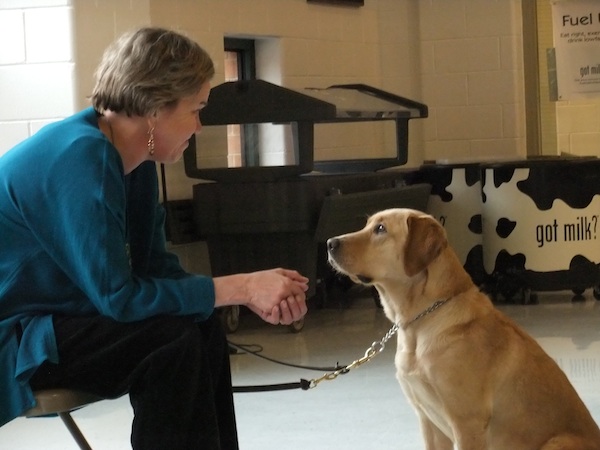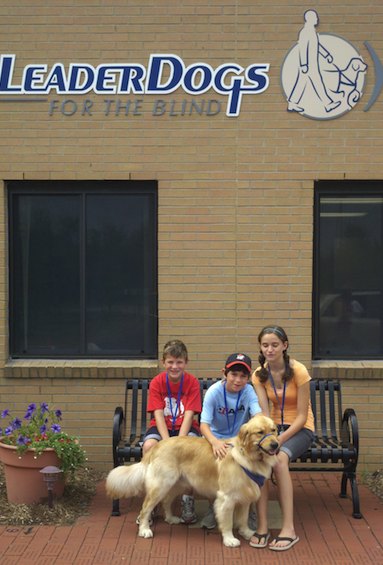Whitney and I squeezed in a school visit last week before we took off for New Orleans, and during my talks with kids at North Barrington Elementary School, I explained three rules
to keep in mind if you happen to see a guide dog with a harness on:
- don’t pet the dog,
- don’t feed the dog,
- don’t call out the dog’s name.
Unlike other schools I’ve visited with Seeing Eye dogs, the students at North Barrington seem nonplussed by these rules. They’d already read Hanni and Beth: Safe & Sound, and, more importantly, one of their teachers is raising a puppy for Leader Dogs for the Blind.
Cindy Hesselbein, the Reading Specialist at North Barrington, brings Labrador retriever puppy Rory to school with her every day. At home, she and her husband and their four children all volunteer their time, money and efforts to raise puppies, and once the pups are a year old they return them to Leader Dogs headquarters in Rochester, Mich., to begin intense training to become a guide. Cindy’s youngest son Daniel was in the car when she picked Whitney and me up at the train station, and he admitted he cried when he said goodbye to Mack, their first pup. “We all did,” his mom added. “But we know it’s all for a good cause.”
More than a dozen schools scattered throughout North America train dogs to guide people who are blind or visually impaired. Most guide dog schools place their puppies with volunteers until the dogs are anywhere from 14 to 18 months old. While Leader Dog puppy raisers are not responsible for training dogs to guide, they do teach social skills, obedience and how to walk in a lead- out position (not like normal obedience training where the dog is behind you at your heel). Cindy got a kick out of watching Whitney turn her head left and right, scanning the environment as she led me through the school. “They don’t do that when they’re puppies,” she observed. “It’s so fun to see the finished product!”
Policies and practices vary in the different guide dog programs in North America. Leader Dogs, where the Hesselbeins volunteer, allows puppy raisers to name the dog they take home. (Mack was named for Michigan’s Mackinac Island, where the Hesselbein family first learned about Leader Dogs.) The Seeing Eye, where I train with my dogs, opts for naming puppies at birth to help keep track of them all.
Another difference: Seeing Eye grads don’t meet the families who raise our dogs as puppies. Leader Dogs has an “open adoption” policy, and it gets mixed reviews from the Hesselbein family. Cindy enjoys keeping up with the young man in Baltimore who is partnered with Mack now, but her youngest son Daniel lamented that attending the Leader Dog graduation to meet the pair meant “having to say goodbye to Mack all over again.”
Cindy asked if Whitney might want to meet Rory while we were at North Barrington School, and I’m sure Whitney would have loved that. She is so new to her job, though, that I thought it might be prudent to keep her on a, ahem, short leash. The two dogs did catch each other’s eye when Rory went out to “empty” during a lunch break. Rory barked out a greeting, but Whitney did not respond in kind. She sat up, and her ears perked, but she stayed quiet, setting an example. After all, Rory was still learning. He’s just a pup, not a professional. Not yet, at least.


I almost sent you an email about this very issue, with a photo of Tom’s current dog, Cate, saying hello to her puppy raiser! (The photo was for Whitney and Mike.) We are big believers in the “open adoption” policies of Southeastern Guide Dogs, where Tom gets his dogs. He finds that the open, easy communication with the people who knew the dog first often yields helpful information about personality quirks, strengths, and weaknesses. The puppy raisers are central to the dog’s success as a guide; without their careful and comprehensive socializing and training, dogs like Whitney and Cate would not be available to humans like you and Tom. I like to think that it is a comfort to the puppy raisers to know for sure that their baby is doing what s/he was born to do: give a blind man or woman freedom. By keeping in touch, the puppy raisers can see for themselves the value of their work.
So true! Without the puppy raisers’ careful and comprehensive socializing and training, dogs like Whitney and Cate would not be available to humans like Tom and me. Puppy raisers are truly the unsung heroes – THANK YOU, all you puppy raisers out there!
Love it Beth, thanks so much! Daniel is very proud today.
…and I’m proud of Daniel, and your entire family, too.
I agree with Lauren. I like that Leader lets us puppy raisers meet the recipients of our dogs (I might add that it is totally up to the student whether he/she wants to meet the raiser and/or correspond with them or not. I respect that entirely). I have made good friends of the people who received the dogs I’ve raised and I love that they ask me about how thier dogs grew up.
Thanks Beth for the shout out for Leader Dogs. I would add that Leader is the second oldest dog guide school in the U.S., established 10 years after the Seeing Eye. It was started by a Detroit area Lions club to help alleviate the demand for dogs that could not be met by the Seeing Eye school alone.
Had no idea that Leader Dogs has been around that long. I knew it had a connection to the Lions Club, but didn’t know this history. Thanks for enlightening me.
Adore that picture of you and Whit. She is totally focused on your face, with her intense gaze.
I think all my dogs looked closely at me over the years (I’m the one who feeds them, after all!!) but Mike uses the exact same word you do when describing the unique way Whitney looks at me: intense.
Do you really think Rory knew Whit was a Seeing Eye dog? I mean, do you think he recognized that she was guiding you?
No, not really. He’s just a friendly guy!
God bless the Hesselbeins and all the other people who foster pups for future work as Seeing Eye dogs! It was interesting reading about that family, especially the kids thoughts on the subject, and the comparisions being Leading Dogs and Seeing Eye.
Amen.
You are most welcome! I’m waiting for TSE puppy #9! I do wish TSE had an optional open contact policy. I do write detailed letters to both the trainer and handler about each pup as they all do have thir quirks! Forewarned is forearmed!
[…] […]
Leave a Response